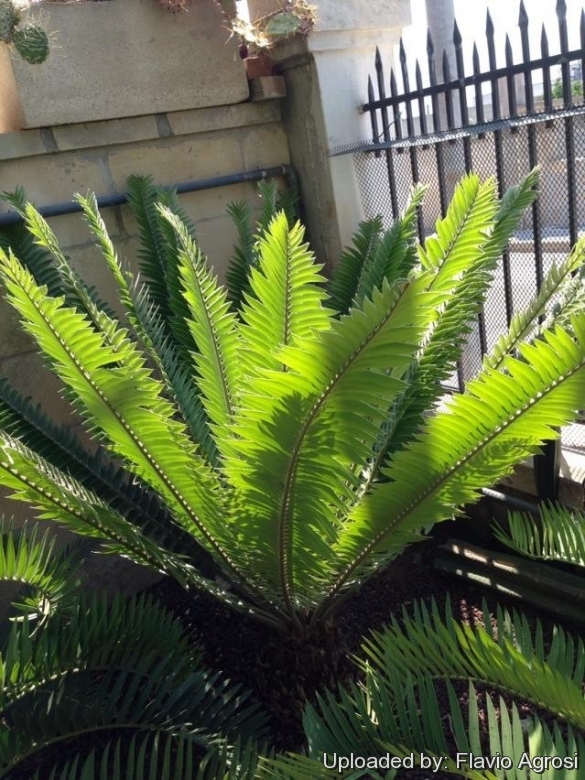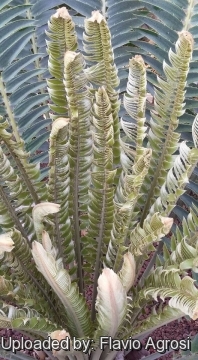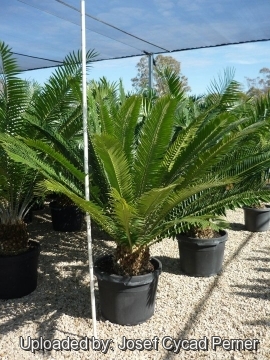




Your support is critical to our success.
Man. Pl. Transvaal [Burtt Davy] 1: 99 (1926)
Family: ZAMIACEAE

Origin and Habitat: Encephalartos transvenosusSN|29893]]SN|29893]] occurs intermittently over a large area in the Limpopo Province, (northern Transvaal), South Africa. In the south the distribution starts in the northern parts of the Drakensberg mountain range. Further northwards a large isolated subpopulation is found in the Modjadji Nature Reserve. The distribution is then taken up in the Soutpansberg mountains. It extends over most of this mountain range and continues further east to the middle of the Thohoyandou area. This species is very abundant in several locations, including the remarkable cycad forest at Modjadji, the only cycad forests in Southern Africa. The Modjadji cycad forest is truly an awe-inspiring place. It is estimated that it contains between 10,000 and 15,000 fully grown E. transvenosus (the largest concentration of a single species of cycad anywhere in the world), with some individuals reaching the astounding eight of 12 metres and there are some other very large subpopulations.
Altitude range: 600 to 1,500 metres above sea level.
Habitat and Ecology: All localities of E. transvenosus are on mountain mistbelt zones. Plants grow in tall grassveld and mixed bushveld, mainly on steep rocky slopes facing southeas. A rainfall greater than 1 500 mm a year is experienced in the region, with frequent mists providing cool, humid summers. The region is free of frost. Porcupines are known to ringbark cycads in some areas and if accessible, the cones are destroyed by the porcupines when they strip the cones of their succulent cone scales. Baboons occassionally break off the immature cones. The Leopard Magpie moth larva is capable of destroying the newly sprouted leaves of a cycad. Certain seed-eating snout beetles of which there are a number of species, can in the case of a heavy infestation, destroy an entire seed crop. The attractive, brightly coloured seeds attract squirrels, baboons, monkeys and dassies. Some birds such as louries, parrots and trumpeter hornbills are also attracted to the seeds. Only the soft tissue covering the seed is eaten and the kernel is then discarded. Plants are removed from the wild by collectors and there is loss of habitat in some places.
Synonyms:
- Encephalartos transvenosus Stapf & Burtt Davy
ENGLISH: Modjadji Cycad, Modjadji's Cycad, Modjadji's palm
AFRIKAANS (Afrikaans): Modjadji-broodboom
SPANISH (Español): Palmera de Modjadji
VENDA (Tshivenḓa / Luvenḓa): Tshhifhanga, Mutondolo, Tshitondolo
Description: Encephalartos transvenosus is a robust, tall-growing arborescent cycad from the genus Encephalartos. It looks like a palm tree with a crown of fairly straight, shiny green, spiny leaves, but producing cones, often resembling those of a pine but far larger. They are dioecious which means male and female cones are produced on separate plants. Mature leaves are straight and flat, with broad leaflets tending to droop away from the rachis. The new leaves are light green covered with fine brown hairs, while the mature leaves dark green and glossy. Leaflets overlap, and carry 3-6 spines on both margins, and basal leaflets gradually reduce to prickles, although leaving some clear petiole. It is thought to be closest to Encephalartos paucidentatus, which has narrower, clearly spaced and mostly entire leaflets.
Derivation of specific name: The species name transvenosus refers to the fine network of veins between the main veins. These can be seen when the leaf is held up to the light.
Stem: Stout erect, generally unbranched, occasionally branched after injury to crown, up to nearly 12 m tall (many between 4-7.5 m), 40-45 cm in diameter deeply scored in a netted pattern, apex of stem with some brown wool. Typical of the species is the appearance of numerous dormant buds along the base of the stem.
Leaves: 150-250 cm long, dark green, highly glossy, flat (not keeled) in section (opposing leaflets inserted at 180° on rachis). Petiole fairly short straight, with no prickles densely tomentose at first, glabrescent, except for pulvinus. Leaf-base collar not present. Rachis yellowish, straight, stiff, recurving towards apex, not spirally twisted. Leaflets preading more or less at right angles to rhachis, broad, lanceolate or ovate, often slightly curved, strongly discolorous, somewhat overlapping upwards, not lobed smooth on upper surface, with unevenly prominent veins on lower surface. Margins flat; upper margin lightly toothed (1-3 teeth); lower margin lightly toothed (1-3 teeth). Median leaflets 16-25 cm long, 25-45 mm in width. Those at the base are reduced to prickles.
Cones: 1-4 borne together on short stout tomentose peduncles.
Pollen cones: Ovoid to subcylindric, yellow, 30-40 cm long, 13-15 cm in diameter, obtusely rounded at base and apex; median scales 4-4-5 cm long, 2-5 cm broad with sharp lateral ridges.
Seed cones: Massive, oblong-oval in outline, yellow, 50-80 cm long, 20-30 cm in diameter, weighing up to 34 kg and are very handsome in the heart of the big green leaves.
Seeds: Oblong, 40-50 mm long, 20-27 mm wide, sarcotesta brilliant orange-red.
Bibliography: Major references and further lectures
1) Donaldson, J.S. 2010. "Encephalartos transvenosus." The IUCN Red List of Threatened Species. Version 2014.3. <www.iucnredlist.org>. Downloaded on 17 December 2014.
2) Whitelock, Loran M., “The Cycads” Timber press, 2002
3) Haynes J.L, “World List of Cycads: A Historical Review” IUCN/SSC Cycad Specialist Group, 2011.
4) Cynthia Giddy “Cycads of South Africa” C. Struik, Cape Town.1984
5) William T. Thiselton-Dyer, Arthur W. Hill “Flora Capensis” Cambridge University Press, 24 lug 2014
6) Dr J.P. Roux “Flora of South Africa” 2003.
7) Ken Hill: “Encephalartos transvenosus” – In The Cycad Pages. <http://plantnet.rbgsyd.nsw.gov.au/PlantNet/cycad/> Downloaded on 16 Dec. 2014
8) J. HUTCHINSON & G. RATTRAY “Flora Capensis” Vol 5, Part 2 (Supplement), page 24, 1933
9) Palmer, E. and Pitman, N. “Trees of southern Africa, covering all known indigenous species in the Republic of South Africa, South-West Africa, Botswana, Lesotho & Swaziland.” Cape Town 1972
10) Gibbs Russell, G. E., W. G. M. Welman, E. Retief, K. L. Immelman, G. Germishuizen, B. J. Pienaar, M. Van Wyk & A. Nicholas. “List of species of southern African plants.” Mem. Bot. Surv. S. Africa 2(1–2): 1–152(pt. 1), 1–270(pt. 2).1987.
11) Stevenson, D. W., R. Osborne & J. Hendricks. “A world list of cycads.” Mem. New York Bot. Gard. 57: 200–206.1990.
12) Wikipedia contributors. "Encephalartos transvenosus." Wikipedia, The Free Encyclopedia. Wikipedia, The Free Encyclopedia, 29 Apr. 2013. Web. 17 Dec. 2014.
13) Christopher J. Earle “Encephalartos transvenosus” 2013 The Gymnosperm Database. <http://www.conifers.org> Web. 17 Dec. 2014.
14) Jones, David L. “Cycads of the World.” Smithsonian Institution Press. 2002.
15) John Winter Kirstenbosch National Botanical Garden March 2005. "Encephalartos transvenosus Stapf & Burtt Davy" SANBI - South African National Biodiversity Institute, South Africa. <http://www.plantzafrica.com> Web. 17 Dec. 2014.
16) Cram101 Textbook Reviews “e-Study Guide for: Biology” Cram101 Textbook Reviews, 01 gen 2012
17) Umberto Quattrocchi “CRC World Dictionary of Medicinal and Poisonous Plants: Common Names, Scientific Names, Eponyms, Synonyms, and Etymology” (5 Volume Set) CRC Press, 03 May 2012
18) Piotor Naskrecki “Relics: Travels in Nature's Time Machine” University of Chicago Press, 31 October 2011
19) Michael Bright “1001 Natural Wonders: You Must See Before You Die” Hachette UK, 16 December 2011

Encephalartos transvenosus Photo by: Flavio Agrosi

Encephalartos transvenosus Photo by: Josef Cycad Perner

Encephalartos transvenosus Photo by: Josef Cycad Perner

Encephalartos transvenosus Photo by: Flavio Agrosi
Cultivation and Propagation: As a garden subject, Encephalartos transvenosusSN|29893]]SN|29893]] is the tallest and one of the most spectacular of all cycad species. With dark glossy green leaves, the seedlings grow rapidly, developing into an attractive garden plant with 1 m long leaves in four to five years. This is one of the fastest growing cycads and responds well to cultivation provided it has a well-drained soil, frost-free conditions and regular watering during the dry months. It is an adaptable plant well suited to warm temperate and subtropical climates. It is more moisture-tolerant than most South African cycads. It can be grown in full sun without its leaves burning. When young they can be grown as a container plant and eventually transplanted into the garden. As a garden plant, this cycad will usually hold two or three crowns of leaves, all in good condition.
Soils: It prefer well drained, gritty soil with plenty of water, especially in dry weather.
Transplanting: This species transplants easily as a mature plant, although it is recommended to remove all of the leaves before doing so. This makes for easier handling and the plant will recover sooner due to less moisture loss.
Waterings: In cultivation prefers moist soil with good drainage for optimal growth. But it is eventually drought resistant. Irrigation systems can be detrimental to cycads, damaging the leaves and stems from the pressure of the water as well as over-watering.
Fertilization: Naturally undemanding for nutrients, it responds very well to regular applications of fertilizer. Growth can be greatly improved through the application of fertilizers. Most growers find that a fertilizer having an even NPK (Nitrogen, Phosphorus, Potassium) balance, and supplemental trace elements, provides a good start for cycads.
Exposure: It thrives and grows best in full sun or partial shade.
Wind tolerance: It prefers a sheltered position providing protection from the prevailing winds.
Hardiness: Frost sensitive.
Traditional uses: The seeds are a brilliant orange-red, and the thin fully ripe flesh surrounding the kernels is relished by the children of the village. In the past, the pith from the stem of cycads was removed, then enclosed in an animal skin, fermented and ground into a meal which was used to make bread.
Propagation: It may be propagated by seeds. They are among the easiest plants to germinate.
| Your Actions | |
|---|---|
| Back to Encephalartos index | |
| Back to Zamiaceae index | |
 |
Back to Palms And Cycads Encyclopedia index |
Privacy stantement - Terms and conditions - How to cite - About us - Feedback - Donate


